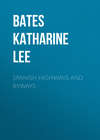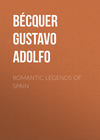Buch lesen: «Spanish Highways and Byways», Seite 17
Not all that heavenward reach of columns and arches, not that multitudinous charm of art, can rid the imagination of a granite weight. I escape for a while to the purer church without, with its window-gold of sunshine and lapis-lazuli roof. When the mighty magnet draws me back again, those majestic aisles are empty, save for a tired sacristan or two, and the silence is broken only by a monotone of alternate chanting, from where, in the Capilla Mayor, two priests keep watch with El Señor.
"He will be here all the afternoon," says the sacristan, "and nothing can be shown; but if you will come back to-morrow I will arrange for you to see even Our Lady's robes and gems."
Come back! I felt myself graying to a shadow already. Of course I longed to see again that marvellous woodwork of the choir stalls, with all the conquest of Granada carved amid columns of jasper and under alabaster canopies, but I was smothered in a multitude of ghosts. They crowded from every side, – nuns, monks, soldiers, tyrants, magnificent archbishops, the martyred Leocadia, passionate Roderick, weeping Florinda, grim Count Julian, "my Cid," Pedro the Cruel, those five thousand Christian nobles and burghers of Toledo, slain, one by one, at the treacherous feast of Abderrahman, those hordes of flaming Jews writhing amid the Inquisition fagots. I had kept my Corpus. I had seen the greatest of all autos sacramentales, Calderon's masterpiece, "Life is a Dream."
"On a single one of the Virgin's gold-wrought mantles," coaxed the sacristan, "are eighty-five thousand large pearls and as many sapphires, amethysts, and diamonds. I will arrange for you to see everything, when Our Lord is gone away."
But no. I am a little particular about treasures. Since Toledo has lost the emerald table of King Solomon and that wondrous copy of the Psalms written upon gold leaf in a fluid made of melted rubies, I will not trouble the seven canons to unlock the seven doors of the cathedral sacristy. Let the Madonna enjoy her wealth alone. I have pesetas enough for my ticket to Madrid.
XIX
THE TERCENTENARY OF VELÁZQUEZ
"It is a sombre and a weeping sky
That lowers above thee now, unhappy Spain;
Thy 'scutcheon proud is dashed with dimming rain;
Uncertain is thy path and deep thy sigh.
All that is mortal passes; glories die;
This hour thy destiny allots thee pain;
But for the worker of thy woes remain
Those retributions slowly forged on high.
"Put thou thy hope in God; what once thou wert
Thou yet shalt be by labor of thy sons
Patient and true, with purpose to atone;
And though the laurels of the loud-voiced guns
Are not with us to-day, this balms our hurt —
Cervantes and Velázquez are our own."
– Duke of Rivas: For the Tercentenary.
The celebration, as planned, was comparatively simple, but enthusiasm grew with what it fed upon. The Knights of Santiago held the first place upon the programme, for into that high and exclusive order the artist had won entry by special grace of Philip IV. Even Spain has been affected by the modern movement for the destruction of traditions, and certain erudite meddlers, who have been delving in the State archives, declare that there is no truth in the following story, which, nevertheless, everybody has to tell.
The legend runs that Velázquez became a knight of St. James by a royal compliment to the painter of Las Meninas. This picture, which seems no picture, but life itself, eternizes a single instant of time in the palace of Philip IV, that one instant before the fingers of the little Infanta have curved about the cup presented by her kneeling maid, before the great, tawny, half-awakened hound has decided to growl remonstrance under the teasing foot of the dwarf, before the reflected faces of king and queen have glided from the mirror, that fleeting instant while yet the courtier, passing down the gallery into the garden, turns on the threshold for a farewell smile, while yet the green velvet sleeve of the second dwarf, ugliest of all pet monsters, brushes the fair silken skirts of the daintiest of ladies-in-waiting, while yet the artist, so much more royal than royalty, flashes his dark-eyed glance upon the charming group.
But if Velázquez looks prouder than a king, Philip proved himself here no uninspired painter. Asked if he found the work complete, the monarch shook his head, and, catching up the brush, marked the red cross of St. James on the pictured breast of the artist. So says the old wives' tale. At all events, in this way or another, the honor was conferred, with the result that on the three hundredth birthday of Velázquez, June 6, 1899, dukes and counts and marquises flocked to the Church of Las Señoras Comendadoras, where the antique Gregorian mass was chanted for the repose of their comrade's soul.
By the latest theology, the "Master of all Good Workmen" would not have waited for this illustrious requiem before admitting the painter to "an æon or two" of rest, but the Knights of Santiago have not yet accepted Kipling as their Pope.
On the afternoon of the same day the Sala de Velázquez was inaugurated in the Museo del Prado, taking, with additions, the room formerly known as the Sala de la Reina Isabel, long the Salon Carré of Madrid, where Raphaels, Titians, Del Sartos, Dürers, Van Dycks, Correggios, and Rembrandts kept the Spanish Masters company. Portico and halls were adorned in honor of the occasion; the bust of Velázquez, embowered in laurels, myrtles, and roses, was placed midway in the Long Gallery, fronting the door of his own demesne; but the crown of the fiesta consisted in the new and far superior arrangement of his pictures. The royal family and chief nobility, the Ministers of Government, the Diplomatic Corps, and delegations of foreign artists made a brilliant gathering. The address, pronounced by an eminent critic, reviewed what are known as the three styles of Velázquez. Never was art lecture more fortunate, for this Museo, holding as it does more than half the extant works of the great realist, with nearly all his masterpieces, enabled the speaker to illustrate every point from the original paintings. A rain of aristocratic poems followed, for a Spaniard is a lyrist born, and turns from prose to verse as easily as he changes his cuffs. As Monipodio says, in one of Cervantes' "Exemplary Tales": "A man has but to roll up his shirt-sleeves, set well to work, and he may turn off a couple of thousand verses in the snapping of a pair of scissors." These Dukes of Parnassus and Counts of Helicon did homage to the painter in graceful stanzas, not without many an allusion to Spain's troubled present. If only, as one sonneteer suggested, the soldiers of Las Lanzas had marched out from their great gilt frame and gone against the foe! A programme of old-time music was rendered, and therewith the Sala de Velázquez was declared open.
To this, as to all galleries and monuments under State control, the public was invited free of charge for the week to come. The response was appreciative, gentility, soldiery, ragamuffins, bevies of schoolgirls with notebooks, and families of foreigners with opera glasses grouping themselves in picturesque variety, day after day, before the art treasures of Madrid, while beggars sat in joyful squads on the steps of the museums, collecting the fees which the doorkeepers refused.
During these seven days, artistic and social festivals in honor of Velázquez abounded, not only in Madrid, but throughout Spain. Palma must needs get up, with photographs and the like, a Velázquez exposition, and Seville, insisting on her mother rights, must arrange a belated funeral, with mass and sermon and a tomb of laurels and flowers, surmounted by brushes, palette, and the cloak and helmet of the Order of Santiago. In the capital the Circulo de Bellas Artes sumptuously breakfasted the artists from abroad. The dainties were spiced with speeches, guitars, ballet, gypsy songs and dances, congratulatory telegrams, and a letter posted from Parnassus by Don Diego himself. Two valuable new books on Velázquez suddenly appeared in the shop windows, and such periodicals as La Ilustración, Blanco y Negro, La Vida Literaria, and El Nuevo Mundo vied with one another in illustrated numbers, while even the one-cent dailies came out with specials devoted to Velázquez biography and criticism. The Academy of San Fernando rendered a musical programme of Velázquez date, the Queen Regent issued five hundred invitations to an orchestral concert in the Royal Palace, and there was talk, which failed to fructify, of a grand masquerade ball, where the costumes should be copied from the Velázquez paintings and the dances should be those stepped by the court of Philip IV.
The closing ceremony of the week was the unveiling of the new statue of Velázquez. Paris owes to Fremiot an equestrian statue of the painter, who, like Shakespeare in his Paris statue, is made to look very like a Frenchman, but the horse is of the most spirited Spanish type. A younger Velázquez may be seen in Seville, at home among the orange trees, and the Palacio de la Biblioteca y Museos Nacionales in Madrid shows a statue from the hand of Garcia. Still another, an arrogant, striding figure, was standing in the studio of Benlliure, ready for its journey to the Paris exposition. The tercentenary statue, by Marinas, is also true to that haughty look of Velázquez. It represents him seated, brush and palette in hand, the winds lifting from his ears those long, clustering falls of hair, as if to let him hear the praises of posterity. Little he cares for praises! That artist's look sees nothing but his task.
The unveiling took place late on Wednesday afternoon, in front of the Museo del Prado, where the statue stands. A turquoise sky and a light breeze put all the world in happy humor. The long façade of the Museo was hung with beautiful tapestries. Handsome medallions bore the names of painters associated in one way or another with Velázquez – Herrera el Viejo, his first master in Seville; Pacheco, his second Sevillian teacher and his father-in-law; Luis Tristan of Toledo, for whom he had an enthusiastic admiration; El Greco, that startling mannerist, whose penetrating portraiture of faces, even whose extraordinary effects in coloring were not without influence on the younger man; Zurbarán, his almost exact contemporary, enamored no less than Velázquez himself of the new realism emanating from the great and terrible Ribera; Murillo, whose developing genius the favored Court painter, too high-hearted for envy, protected and encouraged, and Alonzo Cano, the impetuous artist of Granada, to whom, too, Velázquez was friend and benefactor.
Spanish colors and escutcheons were everywhere. In decorated tribunes sat the royal family and the choicest of Madrid society, with the members of the Circulo de Bellas Artes, who were the hosts of the day, and with distinguished guests from the provinces and abroad. Romero Robledo, as President of the Society of Fine Arts, welcomed the Queen, closing his brief address with the following words: "Never, señora, will your exalted sentiments be able to blend with those of the Spanish people in nobler hour than this, commemorating him who is forever a living national glory and who receives enthusiastic testimony of admiration from all the civilized world." Their Majesties drew upon the cords, the two silken banners parted, and the statue was revealed to the applauding multitude. While the royal group congratulated the sculptor, the ambassadors of Austria and Germany laid magnificent wreaths, fashioned with a due regard to the colors of their respective nations, at the feet of Velázquez. The eminent French artists, Carolus Duran and Jean Paul Laurens, bore a crown from France and delighted the audience by declaring that "the painter of the Spanish king was himself the king of painters." Nothing since the war had gladdened Spain more than the presence and praises of these two famous Parisians; the reverence of Madrid for Paris is profound. The tributes of Rome and London excited far less enthusiasm. Still more wreaths, and more and more, were deposited by a procession of delegates from the art societies of all Spain, headed by Seville, the bands playing merrily meanwhile, until that stately form of bronze seemed to rise from out a hill of laurels, ribbons, and flowers.
This is the first Velázquez celebration which has had universal recognition. The painter was hardly known to Europe at large until the day of Fernando VII, who was induced by his art-loving wife, Isabel of Braganza, to send the pictures from the royal palaces, all those accumulated treasures of the Austrian monarchs, to the empty building, designed for a natural history museum, in the Prado. This long, low edifice is now one of the most glorious shrines of art in the world. It is a collection of masterpieces, showing the splendors that are rather than the processes by which they came to be. There is only one Fra Angelico, but there are ten Raphaels and four times as many Titians. In the Netherlands, no less than in Italy, the Spanish sway gathered rich spoils. There are a score of Van Dycks, threescore of those precious little canvases by Teniers, while as for Rubens, he blazes in some sixty-four Christian saints, heathen goddesses, and human sinners, all with a strong family resemblance. But although the Italian and Flemish schools are so magnificently represented, the wealth of Spanish painting is what overwhelms the visitor. Here are four rooms filled with the works of Goya – whose bones, by the way, arrived in Madrid from France for final sepulture a few days before the celebration. Little more heed was paid to this advent than to that of the United States ambassador, who, it may be noted, was not presented to the Queen until the Velázquez jubilee was well over. But as for Goya, this unnoised entry was appropriate enough, for he, whom De Amicis has called "the last flame-colored flash of Spanish genius," used, during his later life, to make the long journey from Bordeaux to Madrid every week for no other purpose than to gloat upon the Sunday bull-fight, coming and going without speech or handshake, only a pair of fierce, bloodthirsty eyes. This fiery Aragonese painted bull-fights, battles, executions, and Inquisition tortures with blacks that make one shudder and reds that make one sick. He painted the brutal side of pleasure as well as of pain, filling broad canvases with dancing, feasting peasants – canvases that smell of wine and garlic, and all but send out a roar of drunken song and laughter.
Goya lived in the day of Charles IV, whose court painter he was, and against whom this natural caricaturist must have borne a special grudge, so sarcastic are his portraits of the royal family; but his genius is allied to that of Velázquez's powerful contemporary, Ribera. The Museo del Prado has abundant material for a Ribera sala, since it possesses no less than fifty-eight of his works, but the official put in charge of it would probably go mad. The paintings are mercifully scattered and, well for such of us as may be disposed to flight, can be recognized from afar by their dusks and pallors – ascetic faces gleaming out from sable backgrounds, wasted limbs of naked saints tracing livid lines in the gloom of caverns, and, against an atmosphere dark as the frown of God, the ghastly flesh of tortured martyrs, and dead Christs drooping stiffly to the linen winding-sheet. One is appalled at the entrance of the Long Gallery by the two vast, confronting canvases of Prometheus, less a Titan than a convulsion of Titanic agony, and of Ixion, crushed not only beneath the wheel, but under that cold, tremendous blackness of hell made actual. Far down one side of the hall they stretch, those paintings upon paintings of torment, emaciation, the half-crazed visionary, and the revolting corpse. But there is no escape from Ribera, he who
"tainted
His brush with all the blood of all the sainted."
Turning back to the Spanish cabinets that open from the vestibule we come upon a piteous San Sebastian, the blanched young form bound fast and already nailed by arrows to the ebon-hued trunk of a leafless tree. Descending the staircase to the Sala de Alfonso XII, we must pass an attenuated old anchoress, whose sunken face and praying hands have the very tint of the skulls that form the only ornaments, almost the only furniture, of her dreary cave. We may as well brave the terrors of this first half of the Long Gallery, where El Greco's livid greens will at least divert attention, and where, opposite the collection of Riberas, wait the gracious Murillos to comfort and uplift.
Yet Ribera, ruffian though he was, is not solely and exclusively a nightmare artist. He could give sweetest and most tranquil color when he chose, as his "Jacob's Dream" here testifies, with the dim gold of its angel-peopled ladder; and for all the spirit of bigotry that clouds his work, there is Catholic fervor in these pictures and masterly truthfulness up to the point where the senses need the interpretation of the soul. There is more than anatomy, too, in these starved old saints; there is the dread of judgment. Ribera depicts supernatural terror, where Goya shows the animal shock of death.
Another Spanish phase appears in Zurbarán. In his most effective work we have not Goya's blood color, nor Ribera's blacks, nor the celestial violets of Juan de Joanes, but the grays of the monastic renunciation, the twilight that is as far from rapture as from anguish. His gowned, cowled, corded figures pass before the eye in the pale tints of the cloister. The shadow of cathedral walls is over them. The Prado has been strangely indifferent to Zurbarán, who is far more fully represented in the galleries of Andalusia; but it has in its baker's dozen two important and characteristic works, both visions of San Pedro Nolasco. In one the entranced saint, whose figure might be carved in stone, – stone on which ray from stained-glass window never fell, – gazes upon an angel, whose vesture, crossed by a dark green scarf, is flushed with the faintest rose. In the second the sombre cell is illuminated for an instant by the apparition of St. Peter the Apostle, head downward, as in his crucifixion, his naked form dazzling against a vague redness of light like a memory of pain.
One glance at a wall aglow with Madonna blues reminds us that Spanish sacred art does not culminate in Ribera nor in Zurbarán. The Christian faith has had almost as pure, poetic, and spiritual an utterance in the land of the Inquisition as in Italy itself. This is not Murillo's hour; it is the triumph of Velázquez and the realists that Spain is celebrating to-day; but none the less it is a joy of joys to walk by the Murillos on the way to the laurelled bust and the crowded sala. These are the pictures that are rather in heaven than earth. Where Mary, divine in her virginal loveliness, is not upborne among the golden clouds, the radiant-plumed angel kneels on her cottage floor and the wings of the descending dove beat whiteness through the air. Here is realism and more. The Mater Dolorosa has those luminous sea-blue eyes of Andalusia, but they tell of holy tears. The Crucified is no mere sufferer, but the suffering Son of God, and the crown of thorns, while dripping blood, haloes his brows with the redemption of the world.
The genius of Velázquez dwelt not above the earth, but upon it, in the heart of its most brilliant life. He was no dreamer of dreams; he "painted the thing as he saw it," and with what sure eyes he saw, and with what a firm and glowing brush he painted! His sala surrounds us at once with an atmosphere of brightness, beauty, elegance, variety, delight. His work is so superb, so supreme, that, like perfect manners, it puts even the humblest of us at our ease. We are not artists, but we seem to understand Velázquez.
Of course we don't. No knight of the palette would admit it for an instant. What can the rabble know of the mysterious compoundings and touchings from which sprang these splendors of color that outshine the centuries? Young men with streaming hair are continually escorting awed-looking señoras about the room, discoursing with dramatic vehemence on the "periods" of the Master's work. As a youth at Seville, they explain, Velázquez had of necessity taken religious subjects, for the Church was the chief patron of art in Andalusia; but his natural bent even then displayed itself in tavern studies and sketches of popular types, as the "Water-seller of Seville" and the "Old Woman Frying Eggs." Of his early religious pieces the archbishop's palace of Seville keeps "San Ildefonso Receiving the Chasuble from the Hands of the Virgin," and the National Gallery of London secured "Christ in the House of Martha," but "The Adoration of the Kings" hangs here at our right as we enter the Velázquez sala. A little stiff, say these accomplished critics, with a suggestion of the dry manner of his master, Pacheco, but bear you in mind that this is the production of a youth of twenty. It is obvious, too, that Andalusians, not celestial visions, served him as models.
A longing to see the Tintorets and Titians, those starry treasures of the dark Escorial, drew him to Madrid at twenty-three. Here he was fortunate in finding friends, who brought his portraits to the notice of Philip IV, a dissolute boy ruled by the Count-Duke Olivares. Youth inclines to youth. Velázquez was appointed painter to the king at the same salary as that paid to the royal barber, and henceforth he had no care in life but to paint. And how he painted! His first portraits of Philip show a blond young face, with high brow, curled mustache, the long Hapsburg chin, and eyes that hint strange secrets. Again and again and again Velázquez traced those Austrian features, while the years stamped them ever more deeply with lines of pride and sin – a tragic face in the end as it was ill-omened in the beginning. But the masterpiece of Velázquez's twenties is "The Drunkards," a scene of peasant revelry where the young are gloriously tipsy and the old are on the point of maudlin tears. Here it is, Los Borrachos, farther to the right. In looking on it one remembers that a contemporary realist, in the Protestant island which has often been so sharp a thorn in Spain's side, likewise crowned the achievement of his springtime by a group of topers, Prince Hal and Falstaff and their immortal crew.
Not the influence of Rubens, who spent nine months in Spain in 1628-29, painting like the wind, nor a visit to the Holy Land of Raphael and Michael Angelo could make Velázquez other than he was. This "Vulcan's Forge," which we see here, painted in Italy, is mythological only in the title. Back he came at the royal summons, to paint more portraits – Philip over and over, on foot, on horseback, half length, full length, all lengths; the winsome Infante Baltasar, as a toddling baby with his dwarf, as a gallant little soldier, hunter, horseman, and in the princely dignity of fourteen, when he had but three more years to live; the sad French queen, the king's brother, the magnificent Olivares, the sculptor Montañes, counts, dukes, buffoons. Within these twenty years Velázquez produced his two most famous works of religious tenor – "Christ Bound to the Column," a "captain jewel" of the London National Gallery, and that majestic "Crucifixion" before which Spaniards in the Prado bare their heads. But the crown of this period is Las Lanzas, or "The Surrender of Breda," which holds the place of honor on the wall fronting the door. It is vivid past all praise, and nobler than any battle scene in its beauty of generosity. The influence of Italy had told especially on Velázquez's backgrounds. The bright, far landscapes opening out beyond his portrayed figures, especially those on horseback, – and his horses are as lifelike as his dogs, – give to the sala an exhilarating effect of free space and wide horizons.
In 1650 he made his second visit to Rome, where he portrayed Pope Innocent X. Nine years of glorious work in Spain remained to him. Still he painted the king, even at his royal prayers, for which there was full need, and the young Austrian queen, who had succeeded the dead mother of the dead Baltasar. On that happy left-hand wall of the sala shines, in all its vigorous grace, the "Mercury and Argos," but if the hundred eyes of Argos are ready to close, their place is supplied by the terrible scrutiny of a row of portraits, embarrassing the boldest of us out of note-taking. How those pairs of pursuing black eyes, sage and keen and mocking, stare the starers out of countenance! The series of pet dwarfs is here, old Æsop, and Menippus, and the sly buffoon, "Don Juan of Austria." Of these two wonder-works, Las Meninas, "The Maids of Honor," has a room to itself, and thus Las Hilanderas, "The Weavers," becomes the central magnet of this returning wall. A saint picture and even a coronation of the Virgin cannot draw the crowds from before this ultimate triumph of the actual – this factory interior, where a group of peasant women fashion tapestries, while a broad shaft of sunshine works miracles in color.
And this, too, is Spanish. Cervantes is as true a facet of many-sided Spain as Calderon, and Velázquez as Murillo. With all the national propensity to emotion and exaggeration, Spaniards are a truth-seeing people. The popular coplas are more often satiric than sentimental. They like to bite through to the kernel of fact, even when it is bitter. Velázquez, with his rich and noble realism, is of legitimate descent.

















